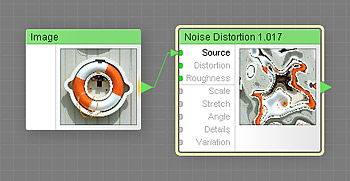
This component is obsolete and its use in filters is not recommended. Use the recent version of the component.
The Noise Distortion component produces a natural-looking distortion effect based on two Perlin noise functions (one for each coordinate). A similar effect can be achieved by using an Offset component with its Offset H and Offset V supplied by two Perlin Noise components with different Variation values. Noise Distortion is a map component, it can be located in the Processing category on the Components Bar.
Provides the source image to be distorted. This is a required input – in order to make Noise Distortion work, this input must be connected.
Distortion: Map Input
Adjusts the distortion amount. The value of 0 has no effect, and the value of 100 results in the maximum distortion. Since Distortion is a map input, its value can be controlled separately for different image areas by connecting a map component to this input.
Roughness: Map Input
Defines the roughness of the noise the distortion is based upon. Technically, Roughness defines the relative transparency of the octaves the noise is composed of (the number of octaves is controlled by the Details parameter). Roughness of 0 sets all octaves but the first to zero transparency, which is equivalent to setting the Details parameter to 0. Low roughness, approximately 0 to 30, results in smoother noise because large-grained octaves have the greatest visibility. Higher roughness values increase the visibility of smaller-grained octaves, making the noise rougher. Roughness has no effect when Details is set to 0, because in this case only one octave is visible. Since Roughness is a map input, its value can be controlled separately for different image areas by connecting a map component to this input.
Lower Roughness can speed up the rendering – when the visibility of smaller-grained octaves is very close to zero, they are 'turned off' to save the rendering time. Also, avoid using Roughness values of 50 and higher for height maps, because this can lead to clamping artifacts which appear as flat regions on the height map.